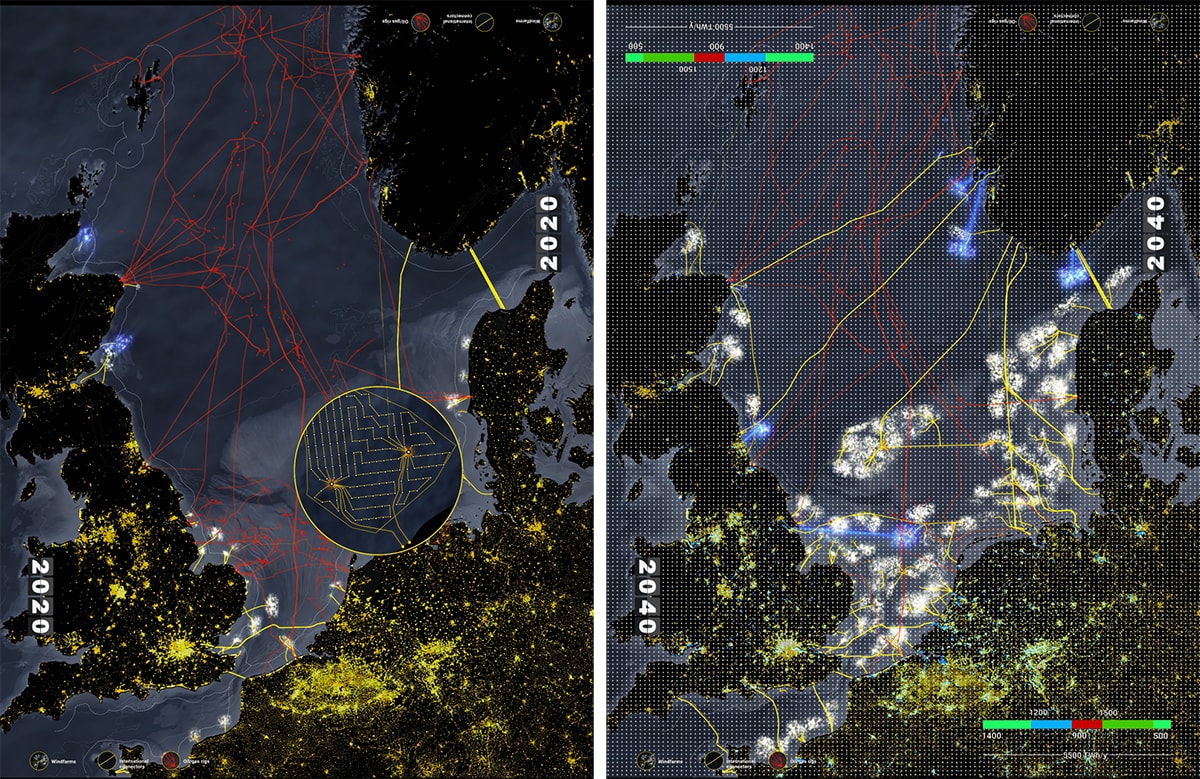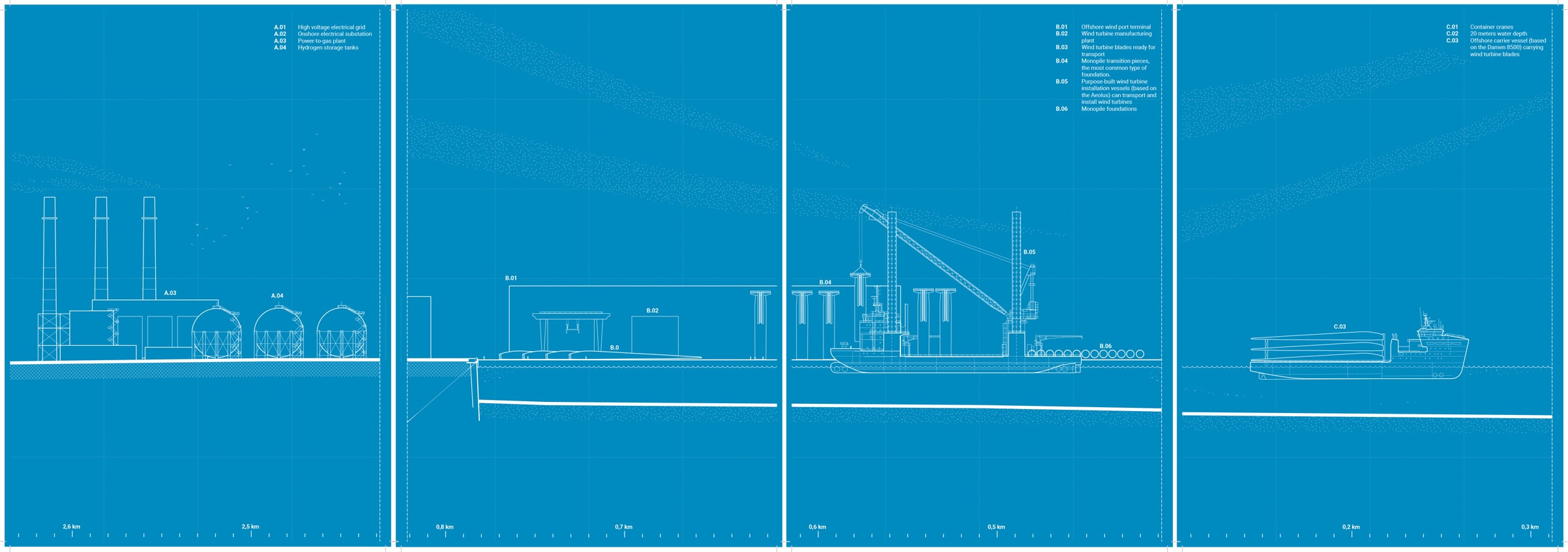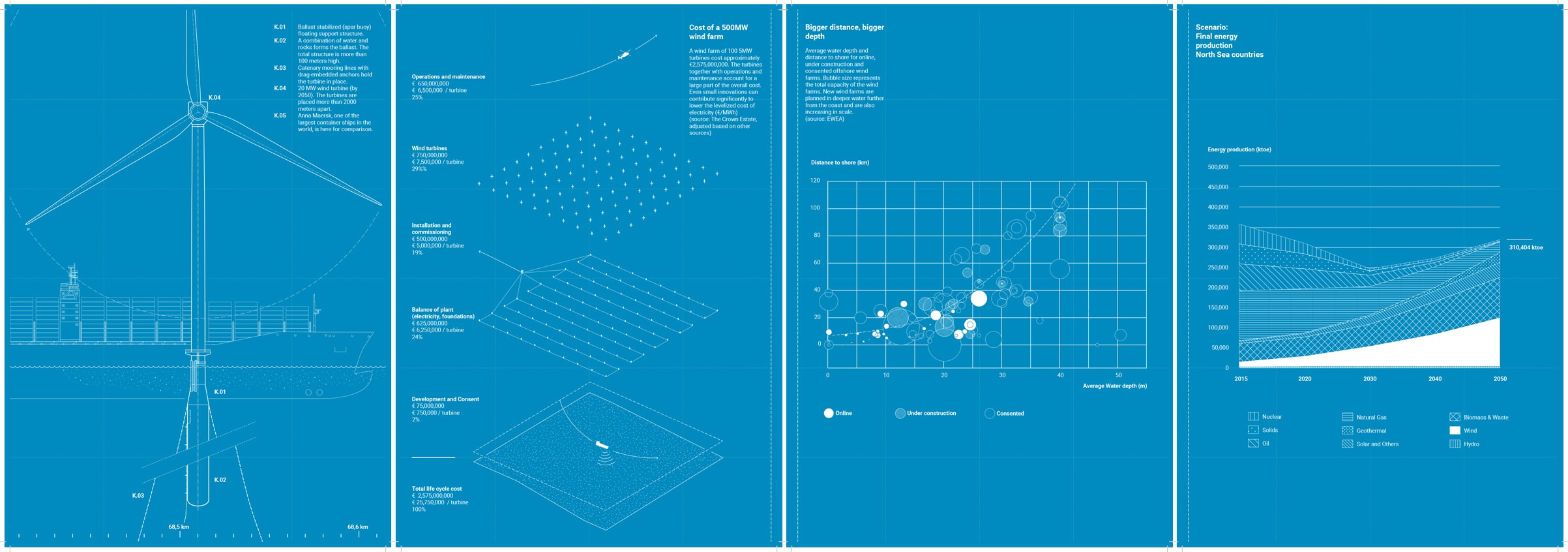“It’s clear that we need to start thinking on a different scale, a huge undertaking that demands the utmost in terms of planning, funding, design, and implementation. This grand operation offers major opportunities for the European economy.
The North Sea, which has been so prominent in our history, will become a pivot in the deep decarbonization of our society, and a source of prosperity for all.”
2050 – An Energetic Odyssey
IABR: 2050 – An Energetic Odyssey from IABR on Vimeo
What is an Energetic Odyssey?
‘2050: An Energetic Odyssey’ is an animated narration showing how the deployment of 25,000 wind turbines on the North Sea could provide some 90% of the electricity demand of the countries bordering the North Sea by 2050. It is designed as a large floor projection of 5.5 meters x 8 meters for the International Architecture Biennale Rotterdam (IABR 2016, themed: The Next Economy), creating an immersive experience.
The floor projection of the 2050 Odyssey animation at the International Architecture Biennale Rotterdam
Motive: a double crisis of the imagination
We observed a crisis of the imagination. The predominant frame in the energy transition holds that fossils are dependent on big installations and centralized state power, while renewables are small and decentralized. This is coupled to a disbelief and skepticism that these ‘soft renewable’ sources will ever be able to fuel an industrial society like ours.
Rather than following this ‘small is beautiful’ frame we wanted to show that a future of renewables can potentially be a massive investment: Big is Beautiful.
We presented an imaginary in which the North Sea would be the powerhouse of renewables. We produced a narrative on how, given the right political ambition and ‘Chinese building speeds’, an energy landscape of thousands of wind turbines might be fitted in one of the world’s most intensively used coastal waters. And moreover, how this grand operation could even result in a positive boost for the marine ecosystem.
Two stills of the Odyssey
The Animated Narrative
The story is told in twelve minutes. At times the narrative closely follows what you see in the projection, and for large parts it roams free using the animation as a backdrop with the calm and the steady unfolding story of the deployment of 25,000 wind turbines. A year-counter displays the time to 2050, while the popping up of infographics show the energy scenario used, the jobs lost and won by substituting the fossil fuel by a renewable offshore industry, the construction island needed to convert AC to DC. Perhaps the most impressive is the illustration of how a turbine park can be shut down when flocks of migrating birds are approaching. At these times the voice-over and the animation are meticulously synchronized. Approaching the end we let the sun come up in the animation while inserted aerial films show the rather moderate visual impact of the wind turbine parks from the shore. The floor projection is supported, first of all by a 12-meter concertina fold containing the scenarios, calculations, and the construction details of the renewable future; and secondly, large flat screens showing contrasting images of the human engineering and the rich underwater life of the North Sea. A third screen summarizes the most important key figures of the narrative.
Two stills of the Odyssey
Behind the screen: the making of…
The interactive production of the installation, in the ‘free cultural domain’ of the IABR, forged a coalition of key actors. These actors not only contributed financially but also gave ‘in kind’ contributions by lending their specialists to inform the narrative and discussing ‘landing rights’ for the intervention. It made the animation an intense collaboration between designers and scientists, and a snowball effect of an expanding consortium with expert input from builders, offshore specialists, ministries, energy firms, a transmission system operator, port authorities, and environmental and nature NGOs. Stakeholders used preliminary versions of the installation and the maps produced by us for their deliberations. Environmental NGOs organized a conference of marine ecologists from the North Sea countries, with the animation used as a backdrop to discuss the pros and cons of such an operation, as well as the ecological development possibilities that they could identify.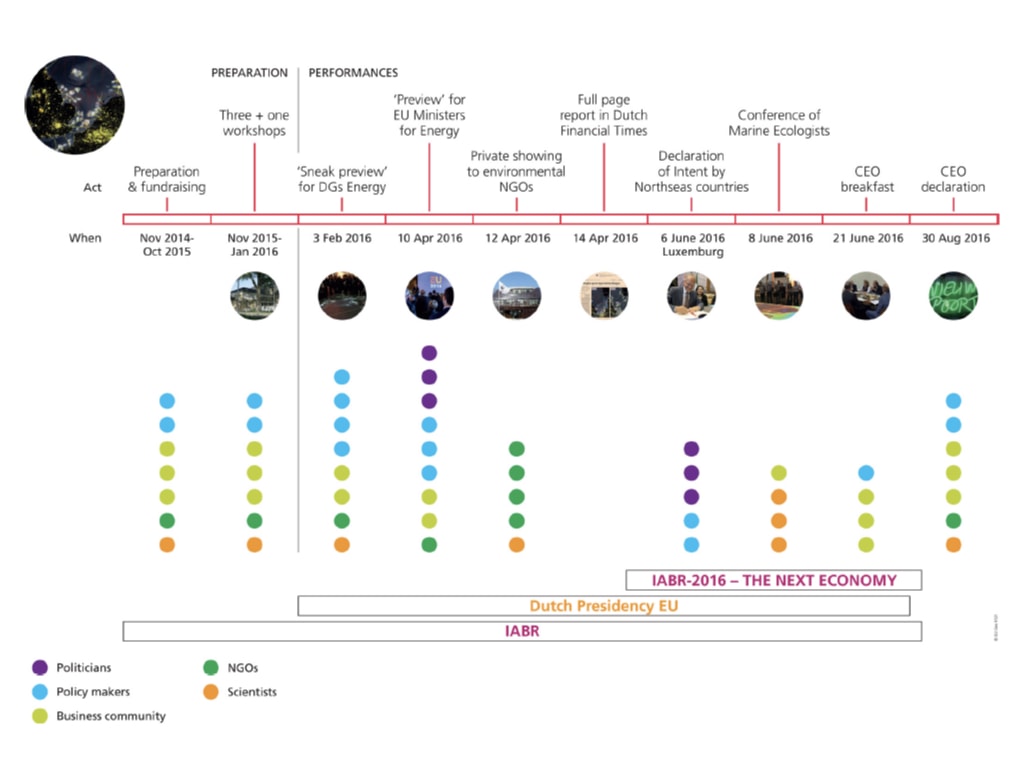
Timeline of events, November 2014–August 2016. The number of dots express the relative weight of the various groups in the respective meetings. Hajer/Pelzer Energy Research & Social Science 44 (2018) 222–231
Elements of the twelve-meter concertina fold with scenarios and calculations
Impact
Showing the early concepts of the presentation started a buzz, word got around, and ultimately, we were invited to give a ‘sneak preview’ of this giant floor projection to the Energy Ministers of the 28 European countries during the Dutch presidency of the EU. Moreover, on the 6th of June 2016, an agreement was signed between the UK, Ireland, Norway, Sweden, France, Denmark, Germany, Belgium, and the Netherlands to boost cooperation on turning the North Sea into our central energy landscape. Of course, this agreement was not ‘design-driven,’ but interviews reveal that sharing the animation and the narrative played a role in this process.
EU Energy DG’s and Ministers overlooking the animation
Based on the animation, a business-led coalition was formed at the Rotterdam Biennale exhibition to urge the Dutch government to speed up its policies to the energy-transition. The Odyssey (again) proved the power of research by design. It shows that with this kind of research it is possible to address problems that will never have a paying client. While in our day-to-day practice our contribution to the big environmental questions of today may be limited, research by design in the free cultural or academic realms considerably broadens the scope of what design might accomplish.
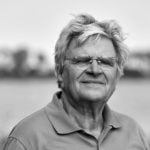 Dirk Sijmons is one of the founders of H+N+S Landscape Architects. At the office he did mostly regional plans and research projects. H+N+S received the Prince Bernard Culture award in 2001. In 2002 he received the Rotterdam-Maaskant award and in 2007 the prestigious Edgar Doncker award for his contribution to ‘Dutch Culture’. His book publications in English are = Landscape (1998), Greetings from Europe (2008), Landscape and Energy (2014), Moved Movement, (2015) & Room-for-the-River (2017). Sijmons was appointed first State Landscape Architect of the Netherlands (2004-2008). He held the chair of Environmental Design (2008-2011) and that of Landscape Architecture (2011-2015) at TU-Delft. He was curator of IABR–2014 themed Urban-by-Nature. At the World Design summit 2017 in Montreal he received the IFLA sir Geoffrey Jellicoe award.
Dirk Sijmons is one of the founders of H+N+S Landscape Architects. At the office he did mostly regional plans and research projects. H+N+S received the Prince Bernard Culture award in 2001. In 2002 he received the Rotterdam-Maaskant award and in 2007 the prestigious Edgar Doncker award for his contribution to ‘Dutch Culture’. His book publications in English are = Landscape (1998), Greetings from Europe (2008), Landscape and Energy (2014), Moved Movement, (2015) & Room-for-the-River (2017). Sijmons was appointed first State Landscape Architect of the Netherlands (2004-2008). He held the chair of Environmental Design (2008-2011) and that of Landscape Architecture (2011-2015) at TU-Delft. He was curator of IABR–2014 themed Urban-by-Nature. At the World Design summit 2017 in Montreal he received the IFLA sir Geoffrey Jellicoe award.
 Maarten Hajer is distinguished professor Urban Futures at the Faculty of Geo Sciences of Utrecht University, director of the UU Urban Futures Studio and scientific director of ‘Pathways to Sustainability’, one of the four Strategic Themes of Utrecht University.
Maarten Hajer is distinguished professor Urban Futures at the Faculty of Geo Sciences of Utrecht University, director of the UU Urban Futures Studio and scientific director of ‘Pathways to Sustainability’, one of the four Strategic Themes of Utrecht University.
He was educated at the Universities of Amsterdam and Oxford and is the author of over many articles and books, including The Politics of Environmental Discourse (Oxford UP, 1995), Deliberative Policy Analysis (Cambridge UP, 2003, eds. with Hendrik Wagenaar), Authoritative Governance (Oxford UP, 2009) and Smart about Cities – Visualizing the Challenge of 21st Century Urbanism (NAi/010, 2014). His co-authored book ‘Neighbourhoods for the Future – A Plea for a Social and Ecological Urbanism’ is due out in 2020. Hajer is a member of the UN’s International Resource Panel (IRP) for which he leads the working group on Cities, together with Mark Swilling (Stellenbosch). He was the Chief Curator of the International Architecture Biennale Rotterdam in 2016.
Notes
2050 – AN ENERGETIC ODYSSEY. Commissioned by the International Architecture Biennale Rotterdam in the context of
IABR—2016—THE NEXT ECONOMY. Concept and narrative: Maarten Hajer & Dirk Sijmons. Realized by: H+N+S Landscape Architects, Tungsten Pro, ECOFys
In Partnership with: Ministry of Economic Affairs of the Netherlands, Royal Dutch Shell, Port of Rotterdam, Van Oord Offshore, RWE, European Climate Foundation, Port of Amsterdam, Zeeland Seaports, TenneT, Natuur&Milieu Foundation,
With expert advice from: PBL: Environmental Assessment Agency of the Netherlands, The Crown Estate, TU-Delft, Eneco, EBN, ROM3D
Copyright: IABR
Further Reading
IABR—2016 The Next Economy, Catalog, Rotterdam, 2016
Maarten A. Hajer, Peter Pelzer 2050—An Energetic Odyssey: Understanding ‘Techniques of Futuring’ in the transition towards renewable energy Energy Research & Social Science 44 (2018) 222–231
Dirk Sijmons When Research by Design takes Politics on a Sabbatical Detour in: George Brugmans, Jolanda van Dinteren The Next Economy, Catalog of The Next Economy, Catalog of the IABR—2016
Cite
Dirk Sijmons and Maarten Hajer, “2050 – An Energetic Odyssey: Persuasion by Collective Immersion,” Scenario Journal 07: Power, December 2019, https://scenariojournal.com/article/2050-an-energetic-odyssey/.


